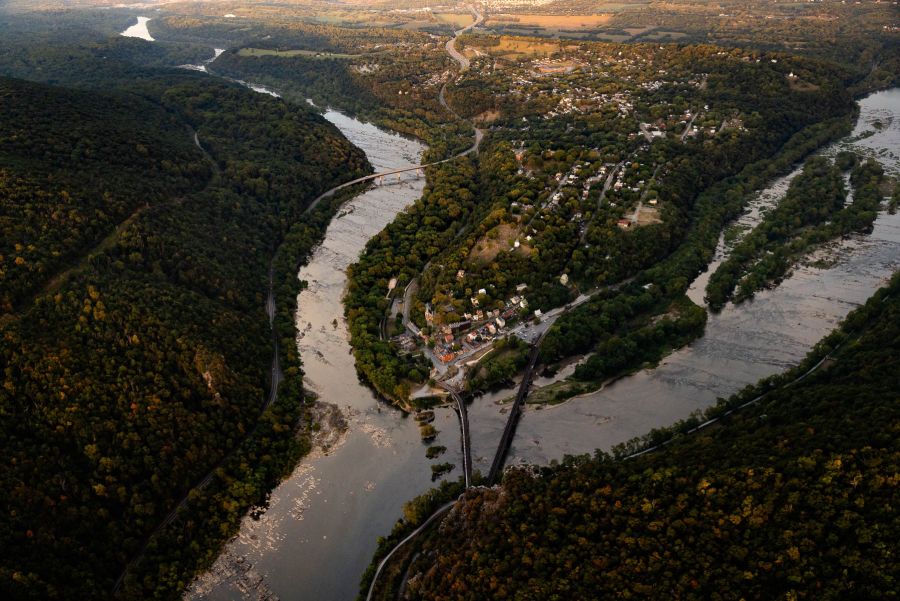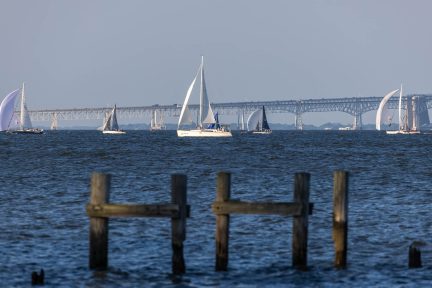Chesapeake water quality sees slight decline
Model shows decrease in nitrogen pollution, increase in phosphorus pollution entering Bay

The Chesapeake Bay Program announced today that an estimated 28.1% of the Chesapeake Bay and its tidal tributaries met water quality standards attainment during the 2019-2021 assessment period. This score is slightly lower than the previous assessment period (2018-2020) when Bay water quality standards attainment was estimated to be 28.9%.
Experts believe Bay water quality is still recovering from the impacts of unusually wet weather in 2018 and 2019. This increased amount of rainfall resulted in more nitrogen, phosphorus and sediment pollutants flowing into the Chesapeake Bay from its surrounding watershed, leading to poor water clarity and lower dissolved oxygen, particularly in the deep waters of the Chesapeake. The estimated water quality standards attainment of 28.1% is far below the 100% attainment necessary to fully support survival, growth and reproduction of the Bay’s living resources. Currently, 71.9% of the Chesapeake Bay and its tidal tributaries are likely to be impaired.
As part of our efforts to measure progress toward the Chesapeake Bay Total Maximum Daily Load, or Bay TMDL, this monitoring data is entered into a sophisticated suite of modeling tools that help estimate the pollution reductions that have occurred through 2022. Our modeling tools also consider land use data, manure and fertilizer data, and the information on the implementation and effectiveness of best management practices. Through the Chesapeake Bay Watershed Agreement, the Chesapeake Bay Program has committed to having 100% of pollution-reducing practices in place that will achieve the nitrogen, phosphorus and sediment reductions necessary to meet the goals outlined in the Bay TMDL, by 2025.
Computer simulations show that between 2009—the Bay TMDL base year—and 2022:
- Overall nitrogen decreased 14%, from 297.8 million pounds in 2009 to 255.9 million pounds in 2022, meeting 51% of the goal to reduce nitrogen by 2025.
- Overall phosphorus decreased 13%, from 17.2 million pounds in 2009 to 14.9 million pounds in 2022, meeting 60% of the goal to reduce phosphorus by 2025.
- Overall sediment decreased almost 5%, from 18.9 billion pounds in 2009 to just under 18 billion pounds in 2022, meeting 100% of the goal to reduce sediment by 2025.
It is estimated that in 2022, 85% of nitrogen, 98% of phosphorus and 62% of sediment reductions came from the agricultural sector. The remainder of sediment reductions are believed to have come from the natural sector (forests, scrub, brush, stream banks and beds, wetlands and shorelines).
Three indicators are currently used to estimate progress toward meeting the modeled nitrogen, phosphorus and sediment outcome in the Chesapeake Bay Watershed Agreement (referred to as the 2025 Watershed Implementation Plan outcome). In 2024, two new indicators—the Integrated Chesapeake Bay Watershed Total Maximum Daily Load for Nitrogen and Phosphorus—will begin to be integrated with the existing three to improve the overall understanding of how the Bay watershed is responding to the implementation of best management practices. More information on these new indicators can be found on ChesapeakeProgress.
Facts
Tidal and Nontidal Water Quality
Water quality in the Chesapeake Bay and its tidal tributaries is influenced by nitrogen, phosphorus and sediment pollution derived from the watershed and varies year-to-year due to a number of factors including land use, fertilizer and manure use, wastewater and septic discharges, and river flow. It is evaluated using three parameters: dissolved oxygen, water clarity or underwater grass abundance and chlorophyll a (a measure of algae growth). These parameters are measured at hundreds of stations across the Chesapeake Bay and its tidal tributaries by the Maryland Department of Natural Resources, Virginia Department of Environmental Quality and District Department of Energy and Environment. The resulting data are used to develop an indicator score used for estimating water quality standards attainment. If the Bay and its tidal tributaries are to function as a healthy ecosystem, all water quality standards for all tidal aquatic habitats must be met.
The U.S. Geological Survey (USGS) works with jurisdictional partners to monitor nitrogen, phosphorus and sediment pollution entering the Chesapeake Bay from the River Input Monitoring (RIM) stations located on the nine largest tributaries of the Bay. This monitoring data reflects the nitrogen, phosphorus and sediment pollution entering the Bay from approximately 80% of its entire watershed. The remaining 20% of pollution entering the Bay from the watershed is estimated from wastewater treatment plants, computer-simulated estimates of nitrogen and phosphorus pollution from nonpoint sources, and computer-simulated estimates of air deposition of nitrogen falling on tidal waters.
River Flow, Pollution Loads and Trends
In 2021, average river flow to the Bay measured 54.8 billion gallons per day, a 4.5 billion gallon per day increase from 2020. This brought 286 million pounds of nitrogen, 19.9 million pounds of phosphorus, and 17.7 billion pounds of sediment into the Chesapeake in 2021. These are increases from the previous year (2020) of 16%, 38% and 19%, respectively.
Findings from a recent USGS analysis of 10-year trends (2012-2021) at the nine RIM stations showed mixed results for nitrogen, phosphorus and sediment.
- Trends in nitrogen indicate improving conditions at four stations (James, Patuxent, Potomac and Susquehanna rivers), degrading conditions at four stations (Appomattox, Choptank, Mattaponi and Rappahannock rivers) and no trend at the Pamunkey River station.
- Trends in phosphorus indicate improving conditions at six stations (James, Mattaponi, Pamunkey, Patuxent, Potomac and Susquehanna rivers), degrading conditions at two stations (Appomattox and Choptank rivers) and no trend at the Rappahannock River station.
- Trends in sediment indicate improving conditions at four stations (Pamunkey, Patuxent, James and Susquehanna rivers), degrading conditions at three stations (Appomattox, Choptank and Mattaponi) and no trend at two stations (Potomac and Rappahannock rivers).
The USGS leads the partnership-wide effort to collect data from a comprehensive network of 123 stations in non-tidal waters across the region. This network allows experts to assess the water quality response in streams and rivers to efforts put in place to reduce nitrogen, phosphorus, and sediment from agricultural and urban areas. A recent analysis of nitrogen, phosphorus, and sediment pollution using monitoring data collected from this non-tidal network during 2011-2020 showed mixed results with some stations improving and others worsening.
- Thirty-eight percent of non-tidal network stations show an improvement in the amount of nitrogen pollution, whereas 42% are degrading and 20% show no change.
- Forty-four percent of non-tidal network stations show an improvement in the amount of phosphorus pollution, whereas 23% are degrading and 33% show no change.
- Nineteen percent of non-tidal network stations show an improvement in the amount of sediment pollution, whereas 46% are degrading and 45% show no change.
Modeled Pollution Loads
Each year, the seven watershed jurisdictions report the steps they have taken to reduce nitrogen, phosphorus and sediment pollution from entering the rivers and streams that flow into the Chesapeake Bay to the Environmental Protection Agency. Chesapeake Bay Program experts then run this information through the Watershed Model to estimate how far its partners have come toward meeting the pollutant reduction goals outlined in the Chesapeake Bay Watershed Agreement and the Bay TMDL. Partners have committed to having 100% of practices that would achieve all of the nitrogen, phosphorus and sediment reductions necessary to meet the Bay’s clean water goals in place by 2025. The 2022 estimates were generated through the Chesapeake Assessment and Scenario Tool 2019 (CAST-19) version of the Watershed Model.
Computer simulations show the following jurisdictional-specific breakdown of overall pollution reduction between 2009 and 2022:
- Delaware: Reported pollution controls achieved 29% of the 2025 reduction goal for nitrogen, 31% of the reduction goal for phosphorus and 73% of the reduction goal for sediment.
- District of Columbia: Reported pollution controls achieved 100% of the 2025 reduction goal for nitrogen, phosphorus and sediment.
- Maryland: Reported pollution controls achieved 60% of the 2025 reduction goal for nitrogen, 39% of the reduction goal for phosphorus and 100% of the reduction goal for sediment.
- New York: Reported pollution controls achieved 60% of the 2025 reduction goal for nitrogen, 72% of the reduction goal for phosphorus and 22% of the reduction goal for sediment.
- Pennsylvania: Reported pollution controls achieved 21% of the 2025 reduction goal for nitrogen, 48% of the reduction goal for phosphorus and 49% of the reduction goal for sediment.
- Virginia: Reported pollution controls achieved 84% of the 2025 reduction goal for nitrogen, 70% of the reduction goal for phosphorus and 100% of the reduction goal for sediment.
- West Virginia: Reported pollution controls achieved 100% of the 2025 reduction goal for nitrogen, 95% of the reduction goal for phosphorus and 100% of the reduction goal for sediment.
Issues
Excess nitrogen, phosphorus and sediment are among the leading causes of the Bay’s poor health. Nitrogen and phosphorus can fuel the growth of algae blooms that lead to low-oxygen dead zones. These conditions can suffocate plant and animal life and reduce the habitat that is available to them. Sediment can block sunlight from reaching underwater grasses and bury shellfish.
The seven watershed jurisdictions, in coordination with local governments, businesses, non-governmental organizations and individuals have installed best management practices to lower the amount of nitrogen, phosphorus and sediment pollution that enters local waterways and the Chesapeake Bay. However, management actions taken to decrease pollution from point sources (e.g., wastewater treatment plants) may immediately show detectable pollution changes, but in regard to the implementation of best management practices for non-point sources, there is often a time lag (e.g., years to decades) in measuring their impact on improving water quality and the health of the Bay.
Importance
By incorporating the best available data into our computer simulations and pollution estimates, the Chesapeake Bay Program can more accurately track partners’ progress toward their pollutant reduction goals. These data give state agencies and local leaders the science-based information they need to assess the effectiveness of best management practices in how they are improving water quality and the health of the Chesapeake Bay.
Tracking the progress that each jurisdiction is making toward reducing nitrogen, phosphorus and sediment pollution entering not only the Chesapeake Bay, but also their local waterways, is helping to improve overall water quality and restore habitat for many of the region’s living resources. A more accurate picture of pollution in the watershed provides an overall more thorough understanding of how the actions that are being taken to restore water quality moves the partnership forward toward an environmentally and economically sustainable Chesapeake Bay.
Quotes
“Despite the slight decrease in water quality, the story of the past two years is one of tremendous improvement, especially in the agricultural sector. The Biden administration is making a generational investment into the Chesapeake Bay—$238 million through the Infrastructure Investment and Jobs Act (IIJA). That money is going on the ground in the form of grants and technical assistance, like the recent partnership with the Environmental Protection Agency, Hershey and Land O’Lakes to improve farm sustainability and water quality in Pennsylvania and ultimately, the Bay. The return on investment from this bipartisan agreement will be felt for years, if not decades.”
- Adam Ortiz, Regional Administrator, U.S. Environmental Protection Agency Mid-Atlantic Region and Chair, Chesapeake Bay Program Principals’ Staff Committee
“Robust monitoring and analysis at local to regional scales showed areas of improvement for some water-quality measures in some of our watersheds. However, the recent declines from the best scores for our water-quality assessment of the bay shows continued efforts are needed to achieve water-quality conditions necessary to protect our living resources now and into the future.”
- Peter Tango, Monitoring Coordinator, U.S. Geological Survey



